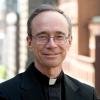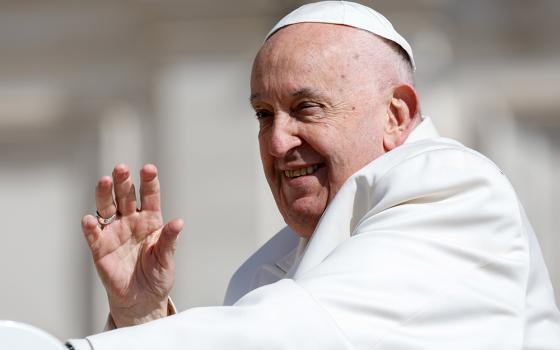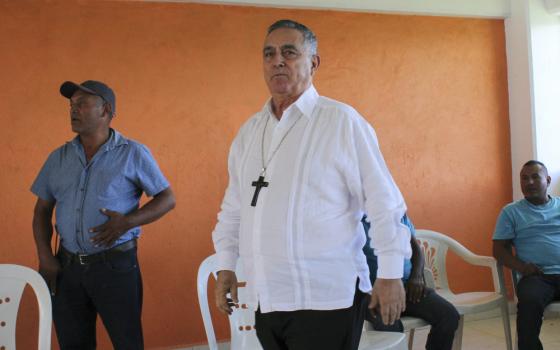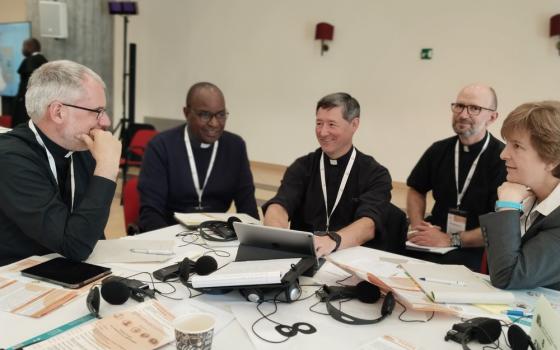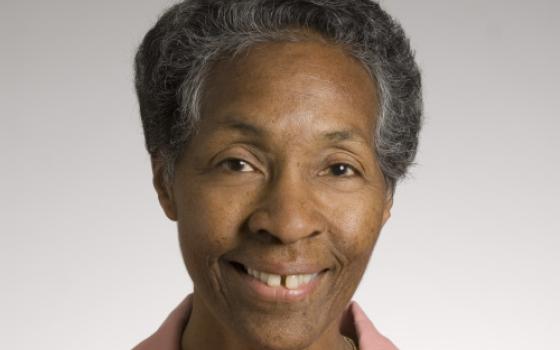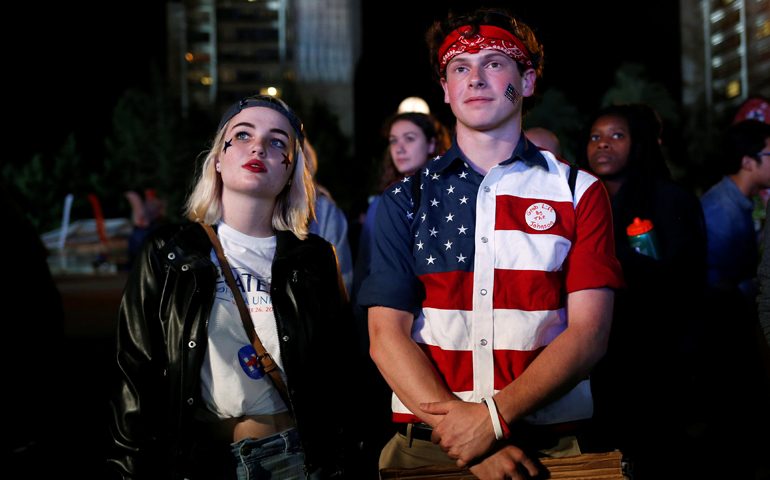
Young people watch the debate between Donald Trump and Hillary Clinton outside Hofstra University, Sept. 27 in Hempstead, N.Y. (CNS/Shannon Stapleton, Reuters)
Earlier this week at a Fordham University panel discussion on the election, I was asked, "Is there some similarity between the dissatisfaction and disengagement we see among Americans for religious institutions with the same phenomena for political parties?"
It is a thought provoking question. There are some interesting parallels between what is happening in the political and religious arenas.
First, the percent of people who do not identify with a political party has been increasing just as the percent of people who do not identify with a religion are increasing. This is bad news for both political parties and churches.
In 2014, 39 percent of Americans identified as independents, 32 percent as Democrats and 23 percent as Republicans according to Pew Research Center. Pew reported that "this is the highest percentage of independents in more than 75 years of public opinion polling."
Likewise, the number of people identifying as "nones," that is not identifying with any religion, has also been increasing. Today, according to PRRI, 25 percent of the U.S. population identify as nones, about the same as identify as Catholics.
It is especially among young people that the percent of nones is rising. Nearly 40 percent of those under 30 are unaffiliated with any religion. The alienation of young people from religious institutions is a growing phenomenon.
Young people also tend to identify as political independents more than do their elders.
This growing alienation does not look good for either political parties or organized religion.
The reasons people abandon organized religion and political parties are similar.
- The institution is not fulfilling their needs. Both parties and churches are not serving the felt needs of many people, especially the young.
- They do not believe in its platform (teachings). Parties and churches are speaking to activists and elites, not to real people.
- They are disillusioned with the institution's leadership. Political and religious leaders have been caught in lies and cover-ups. Too many have been caught in sexual and financial impropriety. They do not believe in transparency. They use their positions for their own advancement rather than in service to their people. As a result, Pew reports that only 3 percent of Americans have a great deal of confidence that elected officials will act in the best interests of the public. Religious leaders do only slightly better: 13 percent.
In short, people feel betrayed and abandoned by the institution, and their response is to abandon the institution whether it is a party or a church.
The conflicts within political parties and religious organizations are also significant. Various factions are fighting over the soul of the institution, whether church or party.
The Republican Party is divided among evangelicals, business elites, tea party activists, and establishment politicians. The divisions are so great many observers are wondering whether the party will survive this election.
Democrats are also divided between progressive activists and establishment politicians. Hillary Clinton is having a hard time getting the Bernie Sanders supporters excited enough to come out and vote. Without them, she is in trouble.
Likewise, churches are divided. Progressive Catholic activists didn't like Benedict and now conservative Catholic elites are upset with Francis. As can be seen from the emails hacked from the Clinton campaign and released by WikiLeaks, Catholic progressives badmouth conservative Catholics, while a perusal of conservative blogs will show conservatives doing the same toward liberal Catholics.
These religious and political disputes are seen in apocalyptic terms. The world will come to an end if my opponents win. Those fighting see everything as a matter of principle, which cannot be compromised. The fights are often bitter with people abandoning the party or church if they lose.
One difference between political and religious conflicts is that conflicts between religious groups in the United States have declined, whereas conflicts between the two parties have increased.
Catholics, for example, have better relations with mainline Protestants, Evangelicals, Jews, and Mormons than at any time in American history. It is not perfect, but the attitude of religious bodies toward one another is a lot better than previously. The only major exception is Islam, which is suffering from growing antagonism in the U.S.
Related: "Lutherans and Catholics chart path to unity" (Oct. 19, 2016)
In short, ecumenism has succeeded where bipartisanship has failed. Partisanship reached new heights when the Republican Congress decided in principle to oppose anything on the Obama legislative agenda.
But religious groups are harder on dissidents in their own ranks than on adherents of other faiths. I was always struck by the fact that during the last two papacies Catholic leadership was willing to dialogue with people of any other faith but was not willing to dialogue with Catholic dissidents.
Party members, on the other hand, hate political opponents within and outside their party ranks. Often the only thing that unites party members is their opposition to the other party. They may fight like crazy in the primaries, but they unite against the other party during the convention.
Churches, for the most part, have moved beyond that and no longer want to have fights with other churches.
A final similarity is that religious and party followers are both looking for a messianic leader to implement their views and save the world. Conservative Catholics saw John Paul as this leader, while progressive Catholics look to Francis. Antiestablishment Democrats turned to Bernie Sanders, and antiestablishment Republicans turned to Donald Trump. Establishment types liked Hillary Clinton and Jeb Bush.
The problem with putting your hopes in one leader is that you can be disappointed, as many Democrats were by President Obama. He failed to accomplish all the things he promised, although his defenders will point out that it was the Republican Congress that stopped him.
The similarity between the problems faced by political and religious institutions should not surprise us. Both institutions are made up of human beings. Both institutions are striving to deal with the most important issues facing humanity. Political and religious institutions have experienced problems for centuries, but somehow humanity has muddled through.
Today, however, the stakes are very high. We need to get it right. We need to figure out how to make these institutions work for the common good of all humanity.
[Jesuit Fr. Thomas Reese is a senior analyst for NCR and author of Inside the Vatican: The Politics and Organization of the Catholic Church. His email address is treesesj@ncronline.org.]
Editor's note: We can send you an email alert every time Thomas Reese's column, Faith and Justice, is posted. Go to this page and follow directions: Email alert sign-up.




